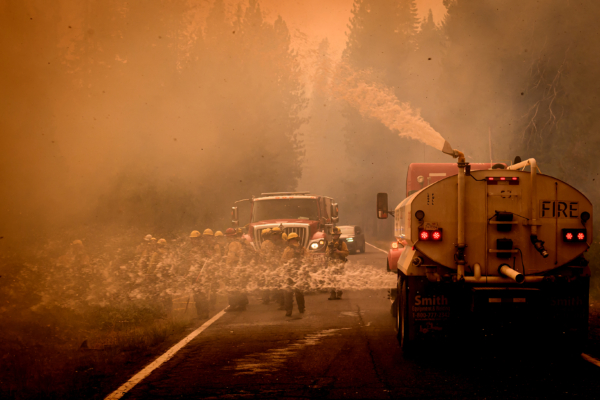This summer, wildfires have been raging in California, burning over 3,200 square kilometers of land and causing a decline in air quality for residents. Experts point out that this has particularly severe impacts on asthma patients.
Official data shows that in Northern California, the ongoing Park Fire has burned an area of over 1,700 square kilometers, with only 39% of the fire currently under control.
According to statistics from Cal Fire and the U.S. Forest Service, the Park Fire is just one of over 5,000 wildfires in California this year. The smoke pollution generated threatens the health of certain groups of people, with these risks increasing after consecutive summer wildfires.
William Barnett, National Advocacy Senior Director for Clean Air at the American Lung Association (ALA), stated, “In recent years, California residents have been gradually adapting to the significant challenges posed by wildfire smoke.”
Barnett pointed out that under normal circumstances, at least 90% of Californian residents live in communities affected by air pollution. There are approximately 3 million asthma patients in the state, including around 475,000 children.
Asthma is a chronic lung disease that causes difficulty breathing, with symptoms including shortness of breath, coughing, wheezing, and chest tightness. Barnett said, “Air pollution can be a major factor and trigger in causing these issues.”
He mentioned that wildfire smoke complicates the condition of asthma and advised individuals with this chronic disease to limit outdoor activities when there is smoke in the air.
Even for non-asthmatic residents of California, prolonged inhalation of wildfire smoke (which may contain particles from burning trees, houses, plants, and chemicals) can have adverse effects.
Barnett stated, “One thing is certain, inhaling particle pollutants increases the risk of lung cancer.”
Long-term exposure to pollutants like wildfire smoke may lead to the gradual onset of asthma in individuals who were not previously diagnosed with the condition.
“If the smoke irritates your lungs, it can cause lung fibrosis and reduce lung function,” said Kenneth Mendez, CEO of the Asthma and Allergy Foundation of America (AAFA). “Asthma and allergies are immune system reactions.”
He emphasized that treating asthma requires consultation with a doctor to ensure the correct prescription medication is used to manage symptoms and reduce inflammation.
Asthma patients can protect themselves from the harm of wildfire smoke by keeping their homes clean and avoiding potentially toxic fine particles.
Mendez suggested reducing outdoor activities during wildfire season, especially in summer and early fall. He also recommended wearing N95 respirator masks to avoid inhaling harmful fine particles.
“Close windows and doors, use fans and air conditioning. If your home has central air conditioning, use high-efficiency HVAC filters, choose a MERV13-rated filter,” Mendez advised.
He pointed out that the higher the MERV rating, the more effective the filter is at removing dangerous particles from the home.
Additionally, he recommended using portable air purifiers equipped with high-efficiency particulate air (HEPA) filters, but also cautioned against purchasing equipment that produces “ozone,” as ozone in such circumstances is sometimes generated when machines purify oxygen molecules.
Mendez stated, “Ozone itself can be irritating.”

